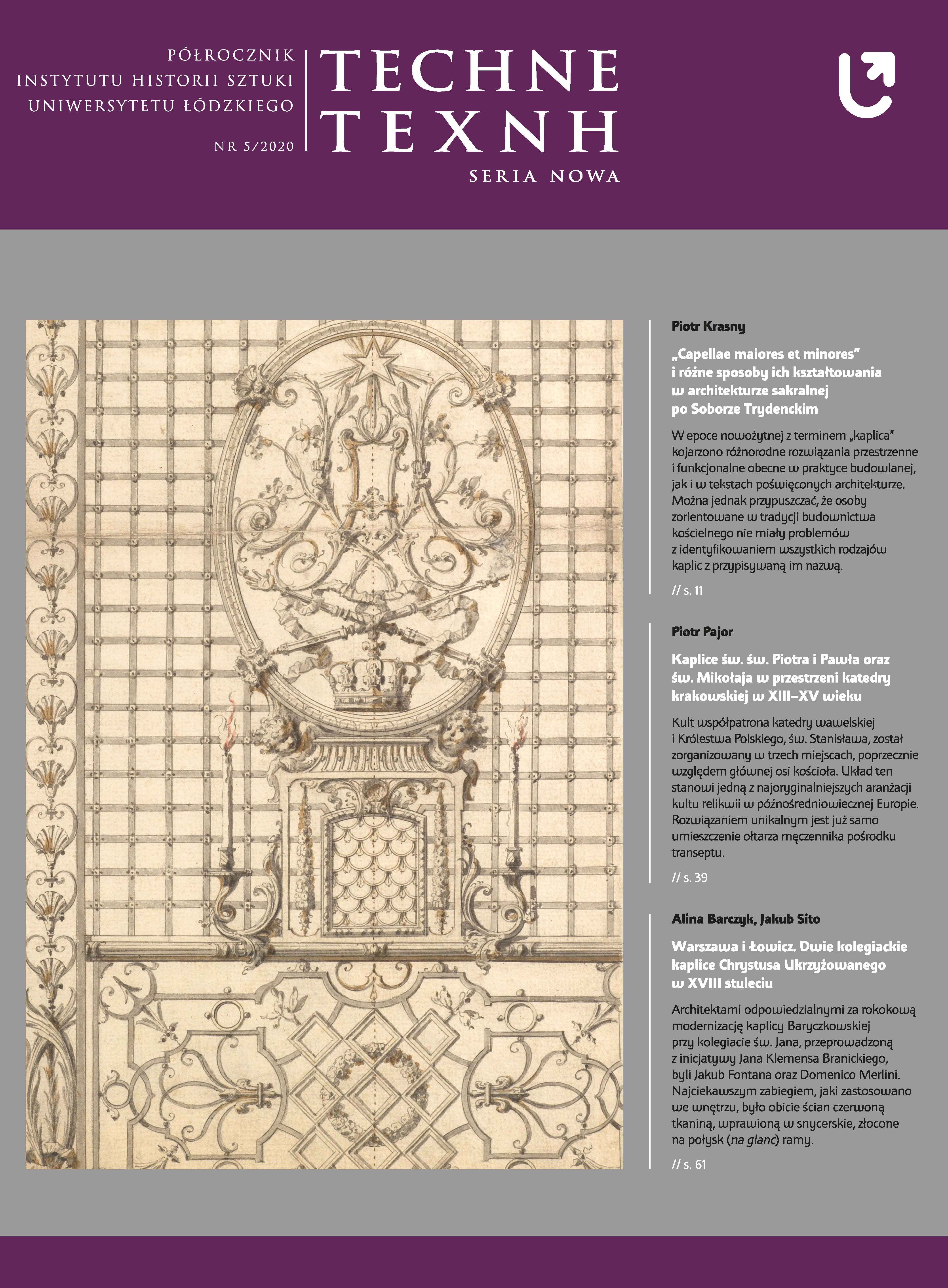Od heretyckiego mauzoleum do katolickiego sanktuarium. Nowe badania kaplicy Matki Bożej przy kolegiacie kórnickiej
From the heretic mausoleum to the catholic sanctuary. New research on the chapel of Mary, mother of Jesus at Kórnik Collegiate Church
Author(s): Jacek KowalskiSubject(s): Fine Arts / Performing Arts
Published by: Wydawnictwo Uniwersytetu Łódzkiego
Keywords: Stanisław Górka; Augustyn Szeps; Teofila Szołdrska-Potulicka née Działyńska; dome chapel; Henryk Horst; renaissance tombstones; Image of Our Lady of the Snow; votive offerings; ex-votive offerings
Summary/Abstract: The parish in Kórnik was established in 1437 thanks to the founders and owners of the town, the Górka family. Probably at the same time the parish church, then still under construction, was consecrated and the bishop of Poznań, Uriel Górka, established a college of canons in 1495. In the mid-sixteenth century, the Górkas converted to Protestantism and gave the church to dissenters. As they then lost their right to burial in the ancestral chapel at the Poznań cathedral, the last member of the family, Stanisław Górka, built a mausoleum in the form of a domed chapel at the parish collegiate church, where his brothers Łukasz and Andrzej, and ultimately also Stanisław himself, were buried (+1592). The architectural structure of the mausoleum is still legible, despite the subsequent liquidation of the dome and changes in the shape of the window openings. In 1584, Stanisław made an agreement with Henryk Horst, a Lviv sculptorfrom the Netherlands, to make three tombstones. The differences in the form of the preserved figures do not allow us to determine whether Horst fulfilled his obligation by carrying out these works with the help of his associates, or whether he made only one tombstone, and the other two come from the beginning of the 17th century, when the chapel was completed by his Catholic nephew Jan Czarnkowski – the foundation plaque bares date 1603. The researchers’ opinions as to the authorship of the statues are divided. Czarnkowski gave the church back to his fellow believers. The tombstones have not been preserved in their entirety. The alabaster and marble figures of the dead, the alabaster bas-relief of the Allegoric Crucifixion and the crucifix and several other fragments that are located in various places of the church. Some of them were made of alabaster from a quarry near Lviv, some of alabaster from the Netherlands. The allegorical crucifixion is entirely a Dutch import. A large number of sandstone and alabaster details, probably from the architectural frames of the tombstones, is kept in the basement of the Kórnik Castle (today the Kórnik Library of the Polish Academy of Sciences). After the church was regained by Catholics, they set up the sanctuary of the miraculous image of Mary in the type of Our Lady of the Snow. Initially, the painting was located in the altar next to the pillar adjacent to the entrance to the chapel. In 1677 a rosary brotherhood was established with him. The cult of the miraculous image of the Mother of God is evidenced by the sources and a group of magnificent silver votive offerings and ex-votives from the 17th and 18th centuries, the oldest of which, given by nobility, is dated 1650. The younger votive offerings and ex-votive offerings come from the last quarter of the 17th century and later centuries. The 17th and 18th century votive offerings are signed with the names of several mayors of Kórnik and the neighboring Bnin, as well as local craftsmen and peasants from the neighboring village of Pierzchno, in which there was a branch church. It was possible toidentify a few contractors, who were goldsmiths active in the 18th century in Poznań. In the years 1735–1737, the then owner of the Kórnik estate, Teofila Szołdrska-Potulicka née Działyńska, carried out a major renovation of the church and the chapel, which was now designated as a center of Marian cult. Two of the tombstones were moved to the chancel, and a sail vault was built instead of the dome. In 1739, an altar was installed, which incorporatedthe miraculous painting, accompanied by a seven-teenth-century painting of St. Lawrence in the second storey of the retable. However, the present altar setting with the oil-painted curtain of the main painting, showing the handing over of the Holy Rosary by Mary to Saint Dominik, comes from 1777–1783. It was made by the Poznań sculptor Augustyn Szeps (Schoeps) and the local carpenter Fryderyk Dera, and it was founded by the court tailor Józef Pudelewicz and the writer of the Kórnik estates, Józef Matelski, who belonged to the local burgher families. After Teofila’s death, in the last years of the 18th century, her son commissioned the construction of a new sacristy with a founder’s box. At that time, the entire complex of the chapel, sacristy and lodge was combined into one block with a common facade, which hides its internal heterogeneity. Apart from minor changes made in the nineteenth century, the present shape of the chapel and its furnishings reflect the conditionsin the second half of the eighteenth century. From the end of the 18th century, the chapel became a necropolis for the next owners of Kórnik.
Journal: TECHNE. Seria Nowa
- Issue Year: 2020
- Issue No: 5
- Page Range: 133-160
- Page Count: 28
- Language: Polish

